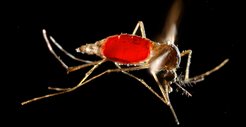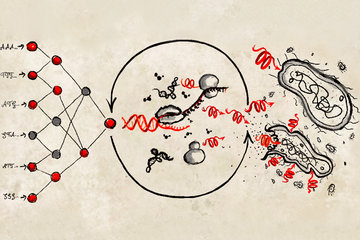'A combination of multiple measures to combat infectious diseases'
Interview with Elena Levashina on the use of genetically modified mosquitoes against malaria
With its annual report "Environment Frontiers", the United Nations Environment Programme (UNEP) shows which challenges will have a decisive influence on the natural foundations of life on our planet in the future. In their report 2018/2019, the authors call "Synthetic Biology: Redesigning our Environment" one of the great challenges of the future. Scientists are changing the genetic make-up of organisms, thereby giving them properties that are useful for humans.

If genes spread faster than normal in a population, this is known as a gene drive. Scientists want to use this mechanism to combat infectious diseases by making the carriers of pathogens such as mosquitoes infertile.
In your opinion, can gene drive be used to eradicate mosquito populations and thus eliminate infectious diseases?
Gene drive is a fascinating mechanism with which we can very quickly change a population. But it's not just about eradicating mosquitoes. It would also be possible to make the animals resistant to certain pathogens or replace one population with another.
Gene drive will certainly not be the cure-all for infectious diseases. The local conditions are too different for that. In Africa, for example, where malaria transmitted by mosquitoes still claims countless lives every year, we will have to combine various measures to defeat the disease. Gene drive can make an important contribution to this.
What does science know about the effects of gene drive?
At the genetic level, it is now pretty very well researched. The laboratory results are very promising in showing that cultivated mosquito colonies can be reliably eliminated.
What about the ecological consequences in the wild?

In fact, there is still a need for research in this area. For example, mosquito species that transmit malaria parasites have complex population structures. In addition, the species that transmit the parasites differ between geographical locations in Africa. Our own research has shown, for example, that one of the two mosquitoes species that transmit malaria in a village in Mali has a higher potential to harbor Plasmodium parasites. What happens if we eradicate or genetically modify the species that is not important vector in the area? Ba removing the competition, such intervention may lead to higher infection rates than before.
For other mosquito species, such as the vectors of Zika and Dengue virus Aedes mosquitoes, population structures are less complex. For this reason, field studies are already being carried out with these species using genetically-based suppression.
In any case, the possible consequences must be carefully examined and the advantages and disadvantages weighed against each other before genetically modified mosquitoes are released into the environment. And, of course, the local population must be involved not only in such decisions but also in the research and implementation of these powerful approaches in the field.













